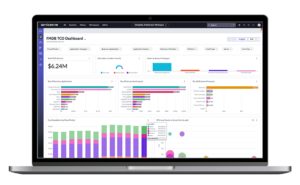From a high-level perspective, the value of cost modeling is relatively simple: it brings full transparency to service costs so they can be measured, optimized, and managed.
But who benefits the most from the transparency cost modeling provides?
The answer is, well, almost everyone… but there are two areas of the organization that stand to benefit most – the office of the CIO and IT Finance.
The excerpt from our recent eBook included below, A Practitioner’s Guide to Cost Modeling, explains the 5 major ways cost modeling is valuable for CIOs and IT Finance, and also how it helps them drive change for the business overall.
Keep reading to see the details, or simply download a full copy of the eBook instantly by clicking here.
Helps Align IT Spend to Business Goals
One of CIOs’ highest priorities (and biggest challenges) is keeping technology spend in alignment with business goals. After all, how can CIOs earn a seat at the table for IT if they can’t show how their budget is driving results for the business?
A cost model assists CIOs in demonstrating value by tracing both forward and backward through each allocation step. By tracing backward, the model shows exactly where existing spend is being directed and the specific services and capabilities it enables. But then by tracing forward – and this is especially powerful – the model can easily demonstrate how new spend can be allocated to power high value projects and initiatives.
In both cases, the CIO gains a valuable tool to bring IT spend into direct alignment with activities the business cares about most.
Silences Budget Attacks and Garners Support for New Initiatives
Without full transparency, customers struggle to understand their IT costs and are often hesitant to trust their bills, which pushes the CIO into constant defense-mode and creates a climate where IT Finance must field endless questions and disputes. It’s a lose-lose all around.
But implementing a cost model alleviates the problem for everyone. It gives customers total visibility of what’s driving their costs; there’s more trust and less skepticism which lifts the burden of constant questioning off IT Finance’s shoulders; and finally, it lets CIOs reframe the spend conversation with facts to justify budgets and easily get buy-in for new projects.
Elevates IT from Cost Center to Business Partner by Developing Trust
Cost modeling provides the means for IT and its consumers to control spend and maximize value collaboratively. When everything’s out on the table, and it’s clear that everyone is working together toward the same goal, a culture of trust and shared accountability starts to grow. And the business starts seeing its relationship with IT very differently.
As time passes, this new dynamic of trust and partnership only gets stronger. And IT can shed its negative “black box” cost center reputation to become a respected voice in strategic decision-making.
Delivers Targeted Insights When and Where They’re Needed Most
Successful cost models refine actionable data for each of IT’s key stakeholder groups, giving decision-makers across the organization exactly the information they need at exactly the times they need it – without having to dig through the numbers manually, sift out irrelevant data, and play email tag to track down what they’re looking for.
For example… cost modeling enables service or tower managers to drive down unit rates and benchmark against peers and third-party suppliers; it helps customers proactively manage their consumption; and it informs application owners on the lifecycle, run cost, and impact of their current and future app investments.
Enables Practitioners to Fully Analyze, Communicate, and Justify Costs
Evaluating costs from every possible vantage point is an invaluable exercise for practitioners, but doing it manually is a never-ending task requiring excessive effort.
Cost modeling makes it simple, since it gives practitioners the means to quickly drill forward and back through every step of an allocation. So rather than spending so much time just figuring out where spend is going, it lets practitioners communicate and justify why that spend is ending up at a certain place (or why it shouldn’t be and how to fix it).
What Else Does Cost Modeling Have to Offer?
These five points are just the beginning of what a successful cost model can accomplish inside your organization. If you want to find out more about what cost modeling is capable of and how you can start using it, take a look at our eBook – A Practitioner’s Guide to Cost Modeling.





